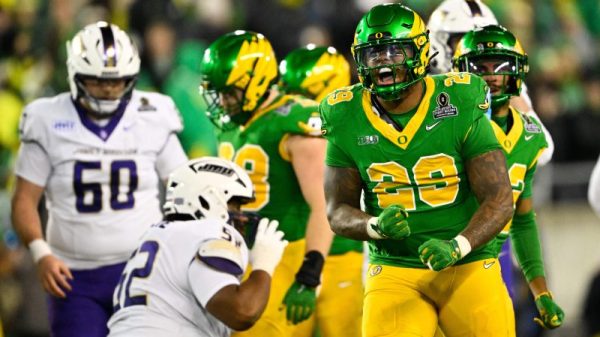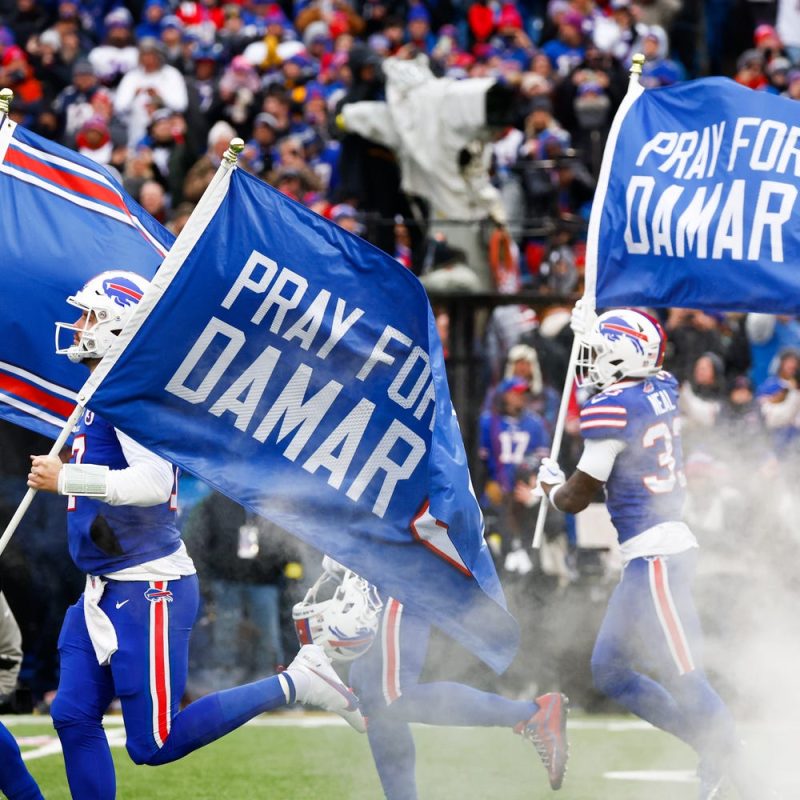When Buffalo Bills safety Damar Hamlin collapsed on the field early in a game against Cincinnati on Jan. 2 and required life-saving CPR, David Silverstein had déjà vu.
Silverstein, a certified athletic trainer, now works with the U.S. Army at the Joint Base Lewis-McChord, just south of Tacoma, Washington. But two years ago, in January 2021, he was sitting in the gym at Shaw High School in East Cleveland during halftime of a boys basketball game when a player rushed onto the floor.
“Z’s down, come quick!”
“Z” was Zaharius Hillmon, a senior guard and younger brother of WNBA player Naz Hillmon.
Silverstein sprinted to the locker room to find Hillmon violently convulsing as a terrified teammate cradled him. Silverstein told the player to carefully lower Hillmon to the floor.
At first glance, as Hillmon’s eyes rolled back into his head, Silverstein thought the teen was having a seizure.
But then, “I did my ABCs, like I’d been trained to do,” Silverstein recalled.
That meant checking Hillmon’s airway, breathing and circulation. Hillmon was gasping repeatedly, a sure-tell sign someone can’t breathe on their own, he said. Silverstein checked Hillmon’s pulse. When he felt nothing, he immediately started CPR.
Hillmon, just 17, was having a heart attack.
It was a shocking, terrifying moment — and one too common in sports. Deadly cardiac events are well-known in arenas and playing fields across the world, from Hank Gathers to Pete Maravich to Olympic ice skater Sergei Grinkov.
But it is most common among those who aren’t playing in prime time or for big paychecks. Sudden cardiac arrest is the leading cause of death among young athletes, according to the Mayo Clinic, with between one in 50,000 to one in 80,000 deaths per year.
The CDC estimates about 2,000 seemingly healthy people under the age of 25 die each year due to sudden cardiac arrest, a statistic cited by many health organizations including the American Academy of Pediatrics.
Hamlin, like Hillmon, was saved by the quick action of a certified athletic trainer; Bills’ assistant trainer Denny Kellington, who performed CPR on Hamlin, has been hailed as a hero.
But what if no athletic trainer had been present?
One in three American high schools don’t have access to a certified athletic trainer, according to the National Athletic Trainers Association (NATA). And it’s been that way since NATA first started tracking data about a decade ago.
With roughly 24,000 high schools in the U.S., that translates to about 8,000 that don’t have an athletic trainer patrolling the sidelines, a startling number considering nearly 8 million high schoolers play organized sports.
‘Would you let kids play football without shoulder pads?’
In East Cleveland that night, Silverstein told a player to go find the school’s automated external defibrillator (AED), thinking they’d need to shock Hillmon’s heart once he had enough of a rhythm. As Silverstein continued compressions, he worried about the device being fully charged and wondered if the pads were new enough that they’d stick.
Meanwhile, another teammate had run upstairs to retrieve Hillmon’s phone, abandoned on the bleachers after live streaming the first half of the game on Instagram (in January 2021, because of COVID protocols, no fans were present).
The player looked into the phone and shouted for Hillmon’s mom, NaSheema Anderson. “Z fainted, get here now!” She sped to the school, sprinted into the locker room and stopped cold at the scene in front her.
“To watch someone do chest compressions on your child, to know they’re only alive because someone else is pumping their heart for them, nothing can prepare you,” Anderson told USA TODAY Sports, her voice catching. “I will never, ever unsee that.”
Soon, paramedics were there too, using their AED to shock Hillmon before rushing to the emergency room. Silverstein walked back to the bench with the rest of the team, dazed and emotional, desperate to get an update on Hillmon.
It was actually somewhat of a fluke that Silverstein was even on site that night.
On friendly terms with one of the assistant football coaches at Shaw High, Silverstein had volunteered to work as the athletic trainer during football games, knowing the school didn’t have one on staff.
Silverstein said shortly before the end of the season, Shaw’s athletic director — who has since left the school — offered to pay Silverstein to attend basketball games, too.
But even after Hillmon’s cardiac event, Silverstein wasn’t offered a full-time role, and he told USA TODAY Sports the high school did not hire an athletic trainer to replace him when he left town months ago for his new Army gig. The school and district did not respond to request for comment from USA TODAY Sports.
That there’s no full-time trainer on staff infuriates Anderson, even if her son — who was diagnosed with a congenital heart defect that required open heart surgery — is now a healthy, thriving college sophomore dominating intramural hoops at Georgia Southern University.
She’s also gobsmacked that thousands of other high schools are in the same situation.
“How could a school ever explain to somebody’s parent, ‘Sorry, we didn’t have a trainer?’ How is that acceptable?” Anderson said, fury in her voice. “Tell me you don’t have the money and I will show you the photo of me sitting in a dark ICU room holding my child’s hand, praying to God that he survives one more day.
“Don’t have athletics if you can’t support it in totality. Would you let kids play football without shoulder pads?
ATCs, AEDs and EAPs
If you’re going to have a heart attack, the best place to do so, outside of a hospital, is at one of the following locations: an airport, a major sporting event or a casino. In all those scenarios, emergency personnel is nearby and AEDs are easily accessible.
At the Bengals’ stadium that Monday, Hamlin was surrounded by almost a dozen medical professionals within seconds of collapsing. University of Cincinnati Medical Center doctors who operated on Hamlin credited that quick response for why Hamlin displayed ‘no identifiable neurological deficit’ when he woke up in the hospital.
‘We may not have been as lucky if the ambulance didn’t get there when it did,’ Silverstein said. ‘We were in an urban setting, too — what if we’d been in a rural setting and it took the ambulance 20 minutes to get there?
“I told all my colleagues after it happened, this is exactly why we drill emergency action plans.”
And while it’s great if coaches, administrators or bystanders are trained in CPR, it’s not their job to save an athlete in crisis. What’s more, numerous studies have shown few coaches are trained in CPR, and even fewer feel confident in their ability to administer it in an emergency.
“To expect a coach to deal with an injury when they don’t all have the training, it’s unfair to them,” said Kathy Dieringer, the president of the National Athletic Trainers Association. “The bottom line is that if you’re going to prioritize the health and safety of students, you’ll have an athletic trainer there to take care of them.”
Dieringer is empathetic to ongoing budget crises in school districts and said finances are often cited as a reason schools don’t employ athletic trainers. Games that pass without incident or injury can give schools and parents a false sense of security, she said, and many might not realize the necessity until it’s too late.
Sudden cardiac events in high school sports
A quick internet search surfaces dozens of high school athletes who have suffered cardiac events across the country.
Just a week ago, Ashari Hughes, a 16-year-old Las Vegas student, collapsed and died during a flag football game. Though her cause of death has not yet been determined, a family member told FOX5, a Vegas TV station, Hughes had ongoing heart issues and was seeing a cardiologist.
The Clark County School District, where Hughes was a student, told USA TODAY via email that certified athletic trainers are present at both practice and games throughout the district, and Jan. 5 was no different. The certified athletic trainer provided immediate aid to Hughes, and deployed the AED, the school district said.
In La Porte, Indiana, about 30 miles west of South Bend, Julie West had just returned home the evening of Hamlin’s collapse during Monday Night Football, when a friend called with a warning: Don’t turn on ESPN.
In September 2013, Julie’s son Jake, then 17, collapsed during football practice. West told USA TODAY Sports that while there was an athletic trainer on site, that person froze and someone else had to perform CPR. But there was no AED on the sidelines; it was locked away in the coach’s office. After being rushed to the ER, Jake West was pronounced dead.
West has since become a fierce advocate for AEDs, constantly harping on the importance of the life-saving device being not just located in every school but on the sidelines of every athletic event.
“I am never one to judge,” West said. “The problem isn’t that they didn’t know CPR, it’s that they didn’t have drills. I used to be a teacher and we drilled everything — fire, earthquake, active shooter. If we’re not practicing regularly for these events, how could we ever be prepared?”
Dieringer said athletic trainers aren’t critical only for the life-saving care they can provide, but because they’re trained to formulate emergency action plans so that if the worst happens, precious seconds aren’t wasted trying to figure out who’s doing what.
In Kentucky, where AEDs are not required at school sporting events, a law was passed mandating schools create and rehearse emergency action plans after the tragic 2008 death of Max Gilpin, a high school football player who collapsed on the field during a 95-degree day and died of heat stroke.
But in 2020, after Matthew Mangine Jr. died during soccer practice at St. Henry District High in Erlanger, Kentucky, his family filed a wrongful death lawsuit alleging the school had no emergency plan in place.
“I don’t want another family to live what I live every day,” West said, adding that she’s thought for years, “it was going to have to happen to a pro athlete, on TV, for everyone to pay attention.”
‘It’s insane’: No certification required for athletic trainers in California
Like AED requirements, rules and regulations surrounding certified athletic trainers (ATCs), vary widely from state to state.
Currently 49 states, and Washington, D.C., regulate athletic trainers. NATA stresses the importance of distinguishing an athletic trainer from a personal trainer. Most athletic trainers require licensure, which NATA considers ‘the gold standard,’ while New York and South Carolina require certification. Hawaii, which requires registration, is the only state in the U.S. with at least one athletic trainer in every high school.
But the real outlier is California, where more than 800,000 students play high school sports, and where athletic trainers aren’t required to be licensed, certified or registered.
That means that anyone off the street could show up at a California high school, tape some ankles and declare themselves an athletic trainer, without any oversight from the state board or state legislature.
“I guarantee you parents do not know that,’ Anderson said. ‘And think about it: you have to have a license to drive, you have to register if you have a dog and we spend so much time trying to regulate people’s body’s, but we’re not protecting our children? That’s insane.”
According to the CIF, California’s governing body of high school sports, 21% of California schools reported having access to a full-time athletic trainer, while 49% have no access. But the CIF cannot require schools to employ athletic trainers — that mandate must come from the California legislature.
The CIF told USA TODAY in an email that it “encourages” schools to have certified athletic trainers on staff as they are “an integral part of the high school athletic program.”
Hillmon, Anderson and Silverstein would agree.
Though Silverstein is now 2,800 miles away from Hillmon, he checks in regularly with the boy he rescued, peppering Hillmon with questions on his grades, his girlfriend and his health. He talks to mom regularly, too.
“As you can imagine,” Anderson said, “David is my favorite person. This is someone who will always be in our life.”
Like other parents who’ve experienced the trauma of their child suffering a sudden cardiac event, Anderson has made it her mission to educate others on the importance of heart screenings, AED accessibility and CPR knowledge.
“If this happening on Monday Night Football didn’t wake up the rest of the world on how to know CPR and how important trainers are, what else could have?” Anderson said. “The one-third number, it’s startling — and it makes you wonder, who’s looking at all those physical forms and OK’ing them?’
Now, she’ll add getting athletic trainers at every high school to her to-do list.
“Listen, you might see me and other moms on Capitol Hill, because this one-third number is not OK,” Anderson said. “Athletic trainers in high schools should be mandatory; it should be legislative. It’s not about if you think it’s necessary — I’m here to tell you, it is.”
Follow Lindsay Schnell on Twitter at @Lindsay_Schnell



























